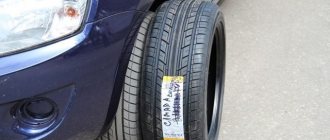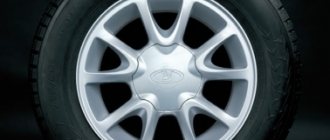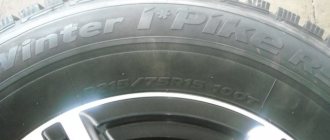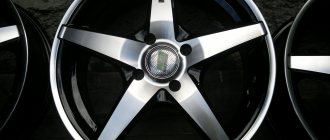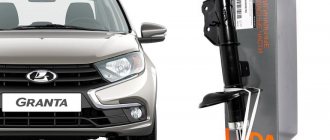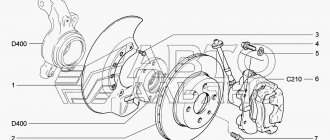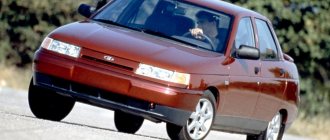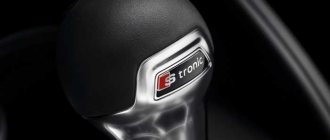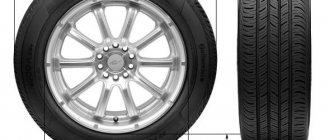Granta is a relatively new front-wheel drive car, developed by VAZ on the basis of Kalina, and launched into production in 2011. Since that time, along with sedan-type models, the Lada Granta liftback began to be produced. The change of body did not affect the tire size, unlike the Sedan Sport modification.
We invite you to familiarize yourself with the parameters of the tires used on these cars, and also present a small selection of models for winter and summer.
Basic tire sizes
In principle, to find out what size tires can be installed on a Lada Granta, just look at the passport or at the plate on the inside of the car door.
Nevertheless, we present to your attention a list of parameters that the manufacturer declares using the example of modifications for the 2022 release:
| Modification | Basic size | Replacement options |
| 2190 Sedan/1.6 16V | R14 175/65 | R14 185/60R15 195/50 and 185/55 |
| 2190 Sedan/1.6 8V | R14 175/65 | No options |
| 2190 Sedan/1.6 16V Sport | R15 185/55 | R15 195/50R16 195/50 |
| 2191 Liftback/1.6 16V | R14 175/65 | R14 185/60R15 185/55 |
| 2191 Liftback/1.6 8V | R14 175/65 | R14 185/60R15 185/55 |
Standard and alternative disks
In the basic configuration, the Lada Granta is equipped with stamped rims, and every car owner thinks about replacing them with alternative ones. The appearance of the car, road stability, handling, degree of tire wear, and fuel consumption depend on these elements. When installing certain wheels, you need to understand which parameters are more important. This is clearly shown in the table:
| Parameter | Increasing width | Diameter increase |
Increasing tire width
The choice is influenced by the material from which the product is made. Metal stamped disks are resistant to damage and reliable, but their main drawback is their heavy weight.
R14 “stamps” are installed on the Grant from the factory.
Wheels made of light alloy materials are much more popular. Their main advantage is the variety of designs, but the cost is higher than stamped ones. According to the manufacturing method, they are distinguished:
Of these, cast ones are the highest quality, popular and reliable.
Tire pressure
We found out which tires are suitable for the Lada Granta - now we’ll figure out the pressure. A lot depends on it during the operation of tires, the purchase of which is one of the sources of expense for any car owner. The pressure must be constantly monitored to ensure that the tires do not wear out too quickly.
Premature wear occurs when there is insufficient pressure, but over-pumping is also fraught with consequences.
- If the pressure is regularly lowered by 0.5 Atm less than the norm for 14 radius of 1.9 Atm in the front, and 2.0 Atm in the rear, the tires will last 4 times less - plus fuel consumption increases.
- With an even greater lack of pressure, the car may lose control and the braking distance increases.
- If you drive for a long time on half-flat tires and then inflate them, the tire may simply explode.
Therefore, you need to have a pressure gauge on hand, take measurements from time to time (especially in winter), and if you need to pump up the wheels. The front and rear pair of tires should have the same pressure.
Specific indicators depend on the wheel size. Take, for example, the 195/50 profile, which is one of the replacement options for the LADA Sedan Sport. If this is a radius of 15, then the optimal pressure is 2.3 Atm, and at radius 16 you need to pump 2.4 Atm.
A short checklist - How to buy tires for the Lada Granta correctly
1. You should look for the right tires, keeping in mind the factory dimensional specifications. The size of the selected tires must match these data. 2
Pay attention to the tread pattern. Driving comfort largely depends on it
3
Pay attention to the width parameters. The acceleration and braking of a car is affected by the width of the spot converging with the road surface.
4. Particular attention should be paid to the bore diameter. Tires that are excessively high or wide can damage the suspension, while tires that are too narrow will increase the load on the bearings. 5
It is important to take into account the maximum speed index and the load capacity index. 6
Treadwear, Traction, Temperature and MaxPressure data provide information on the tire's factory wear life, braking performance, temperature resistance and pressure limit for the tire respectively.
Selection of tires by model
Knowing the size of the “shoes”, all that remains is to choose the style. Any car should have two sets of tires: winter and summer. Winter tires are installed without waiting for frost, but when the thermometer regularly drops below +5 degrees.
To save on the purchase of winter tires, some drivers make the mistaken decision to drive all-season tires. Therefore, we will make a small digression and explain why this should not be done.
When and what tires are needed for a car?
Let’s say right away that there are no tires that behave stably in any conditions. Why then is the tire called all-season? Because of the tread, which must have a deep relief and grooves through which water, dirt, and slush can easily pass.
All-season tires are tires that are comfortable to drive in the off-season, when the air temperature varies from +7 to -10 degrees. It is often marked M+S (mud/snow), which confuses many.
But in fact, an all-season tire is a summer tire and is not suitable for year-round driving, even in the southern regions of the country.
- All mud tires, and all winter tires, have an all-season tread. The only difference is in the rubber composition, which is designed for positive or negative wheel operation. On a winter tire, for better grip on icy roads, many thread-like sipes are made, which distinguishes it from all-season tires.
- Studless winter tires are popularly called Velcro. On such tires, the car feels great in icy conditions, but when the temperature outside is consistently positive (above +6-7 degrees), it must be changed to summer shoes.
- Winter tires are much softer, so if you try to drive them in the summer, they will wear out quickly. Studded tires are better suited for driving on snow, so when in winter you have to drive not on cleared asphalt, but on a country road, it is better to give preference to studded tires.
- All year round, all-season vehicles are driven mainly by trucks and buses, on which changing wheels is a labor-intensive process, and besides, there are usually more than four of them. True, in severe frosts and snowfalls they have a hard time riding on such tires.
And another important factor is for those who spend a lot of time driving. A tire for winter use is much softer than a summer one, but it is also noisy when driving, especially the studded one.
The summer one, and it is also an all-season one, in severe frosts “steals” and just rattles. And this is not to mention the fact that you will not so much ride on the ice as perform figure skating.
Yokohama BluEarth-Es ES32
BluEarth is a good choice for those who like a comfortable and leisurely ride around the city without vibrations and unnecessary noise. It has protection against uneven wear and behaves confidently on wet asphalt. For its production, special rubber compounds made using nanotechnology are used. Tires produced in this way are distinguished by higher strength characteristics and tread resistance to wear.
Reviews of Yokohama BluEarth-Es ES32 tires
Winter tires on Lada Granta
Now let's see which winter tires to choose for the Lada Granta:
Viatti Brina Nordico
A relatively new model, developed by the German Continental together with Italian engineers, and put into production at the facilities of the Nizhnekamsk tire plant.
An asymmetrical tread pattern, a combination of middle blocks with rows of studs along the edges and variable sidewall stiffness technology ensure safe movement and stability when cornering and when crossing uneven roads.
Toyo Observe Garit G3-Ice
Winter tires from the Japanese Toyo are deservedly considered one of the best. If previously only sellers and those who drove it knew about this, then a test carried out at the test site not so long ago left no doubt.
Observe Garit G3-Ice tires competed with the Finnish Hakkapeliitta-7, slightly inferior to it in snowy areas and taking the lead on the compacted track. Experts believe that the whole point is in the studs, which protrude beyond the surface of the tire by 1.2 mm more than normal.
Goodyear UltraGrip 600
Another new product. Atypical tread pattern - as is the case with all Goodyear models. Looking at it, you get the impression that a solid wheel is simply cut into grooves. They provide the tire with excellent handling in loose snow.
Another distinctive feature is the hexagon-shaped studs, which make it possible to quickly accelerate and brake safely.
Hankook W429 i Pike
Winter studded tires of different generations from the Korean manufacturer Hankook have long established themselves as an excellent combination of price and quality. The latest model has been slightly redesigned; the shape of some tread elements has slightly changed, although the symmetry of the pattern and directionality have been preserved.
Massive blocks on the sides replaced narrow ribs, and the tire began to work better in icy conditions.
Design features and markings of Grants disks
The rim is the main part of the wheel that serves to secure the car tire and transmit torque by securing the disc to the hubs. Don’t be confused - the Lada Granta wheel bearing has nothing to do with discs. Structurally, the product consists of two parts:
- rim - comes in different sizes and shapes, serves to fix the rubber;
- flange - with its help it is attached to the hub with bolted connections.
The appropriate tire is selected according to the diameter and width of the wheel. The departure is marked as ET. Conventionally, this is the distance between the center and the mounting surface. The larger it is, the more the wheel extends outward from the wheel arch. The center hole size is marked as DIA, and the diameter of the middle of each mounting hole is marked as PCD. Based on this data, nuts, bolts, and washers are selected.
The best models for summer
Now let's present several worthy summer models:
Bridgestone Ecopia EP150
The tread of this Japanese tire is developed using a new technology (NANO-PROTECH), which makes it possible to reduce the coefficient of rotational resistance and, as a result, save fuel consumption. Plus, the EP150 turned out to be lighter in weight and almost silent.
Nitto NT860
Another Japanese tire produced in Malaysia. Very soft rubber, perfectly balanced and brakes, thanks to the deep tread, self-cleaning from dirt and snow. With all this, the best thing is the low price.
Kormoran Impulser B2
Serbian Kormoran was developed using Michelin technology. The tire is stable when driving at speed, does not “float” if it gets into a puddle, has excellent grip on the road and is controlled when cornering.
Matador MP 47 Hectorra
The new generation summer tire from Slovenia MP-47 Hectorra performs excellently on both dry and wet surfaces thanks to its asymmetrical pattern with four deep longitudinal grooves.
Tread elements are optimized to the maximum, which improves acceleration and braking efforts and reduces noise levels.
Conclusion
Which winter tires are best for a car, or what to put on it for the summer, is, of course, up to the owner to decide. It all depends on what climate zone you have to use the car and what roads you drive on. And our information is designed to understand the characteristics of certain models and the advisability of their use.
Bridgestone Turanza T001
Bridgestone Turanza T001 tires take second place in the honorable ranking of the best summer tires. This is rubber made for travel. It drives on any road, makes no noise and practically does not vibrate. Its durability is comparable to light truck rubber. It has a hard cord and low abrasion. From the point of view of handling and road grip, such a tire is also beyond praise. It has strong sidewalls and a nanoprotector, which further increases its service life and reliability.
Reviews of Bridgestone Turanza T001 tires
fair price
In previous tests, cheap tires often won in the Quality/Price category, which caused controversy.
And we changed the methodology to more accurately determine how justified the price of each tire is: we used the least squares method, popular in statistical and economic calculations, which allows us to establish a linear dependence of the price on the number of points earned in the test. It is this straight line on the statistical data field that displays the fair price for each tire. Those models whose price was above this line are overpriced (yes, that same marketing!). And when choosing any of the models whose prices are below the line, the buyer makes a profitable purchase. The greatest benefit is provided by the GT Radial FE1 City
- as much as 20%.
the Laufenn G Fit EQ
and
Nordman SX 2
tires look a little less tempting . Their actual price is 13% lower than the fair price.
Cost of tires Viatti Strada Asimmetrico V-130
and
Landsail LS388
corresponds to the level of their consumer properties.
The overpayment will be maximum when purchasing Achilles 122
(19%) and
Continental ContiPremiumContact 5
(13%). And if the exclusivity of the Continental’s characteristics to some extent justifies the inflated price tag, then the price of the Achilles against the background of its 781 final points seems completely inadequate.
Field players
IMG_2448
Who participates in our tests? First of all, tires from leading manufacturers. This is the so-called Top Five, the top five: Michelin, Bridgestone, Goodyear, Continental and Pirelli. Another important player is the Finnish company Nokian Tires: the capacity of its plant in St. Petersburg will soon reach 18 million tires per year. In total, these six attackers sell the lion's share of all passenger tires on the Russian market.
The second line includes mid-price tires: BFGoodrich, Sava, Gislaved, Matador, Formula, as well as tires from fast-growing companies such as Yokohama, Hankook, Toyo and other Asian manufacturers.
In defense - budget tires, including domestic ones, for example Cordiant. We also carefully study the tires of young Chinese companies: they do not make a difference on the field, but sometimes we take them into our tests - what if a brilliant newcomer appears and beats everyone?
Old family (until 09.2018)
Sedan
:
| Equipment | Tire size with load capacity and speed indexes* | Disc size | |
| rim width (inches) | rim offset (ET), mm** | ||
| Standard | 175/70 R13 82T, N | 5J | 35 |
| Standard Norm Lux | 175/65 R14 82T, N 185/60 R14 82T, N 185/55 R15 82T, N | 5J, 51/2J, 6J | 35 |
| Sport | 185/55 R15 195/50 R16 | 5J, 51/2J, 6J | 35 |
R is not a radius, but a designation of the radius of the tire, and the number is the diameter of the rim in inches.
Liftback
:
| Equipment | Tire size with load capacity and speed indexes* | Disc size | |
| rim width (inches) | rim offset (ET), mm** | ||
| All modifications | 175/65 R14 82T, N 185/60 R14 82T, N 185/55 R15 82T, N, V | 5J, 51/2J, 6J | 35 |
- * Speed indices: T – up to 190 km/h, H – up to 210 km/h, V – up to 240 km/h. Load capacity indices: 82 – 475 kg.
- **Rim offset (ET) is the distance from the mating plane of the disc to the middle of the rim.
Wheel hub bolt pattern 4x98, DIA - 58.5.
